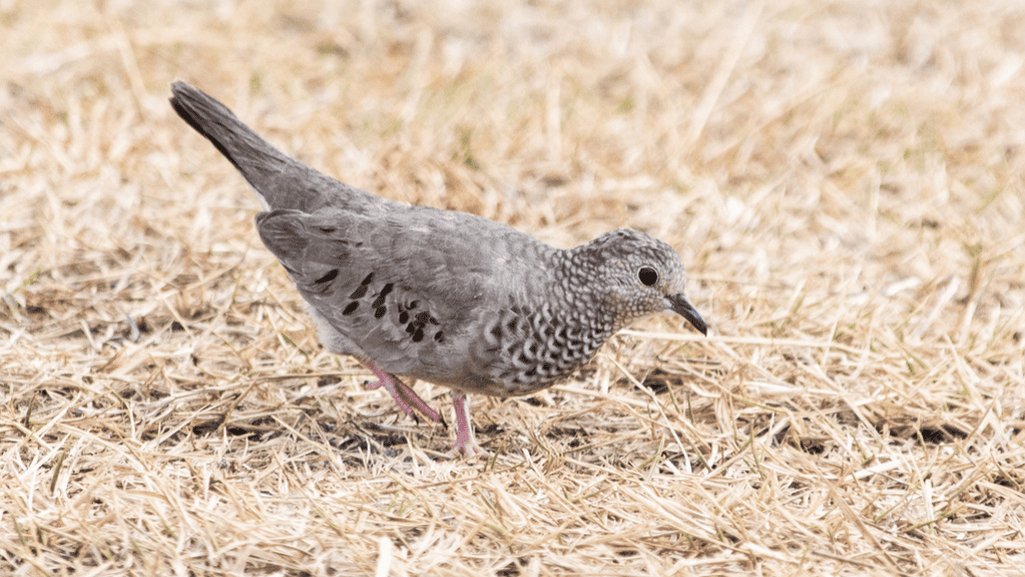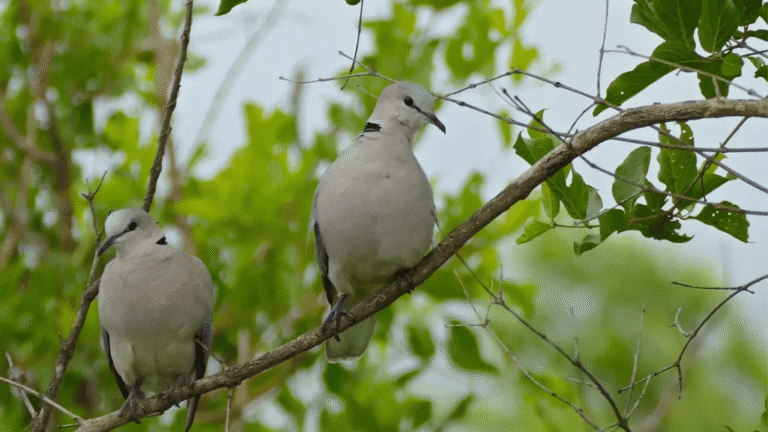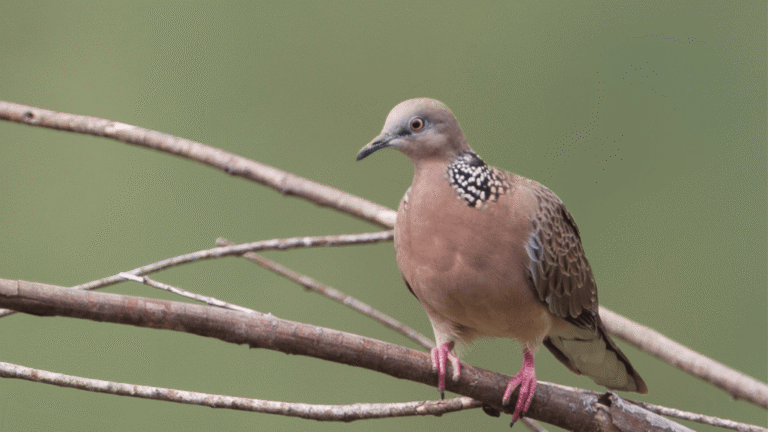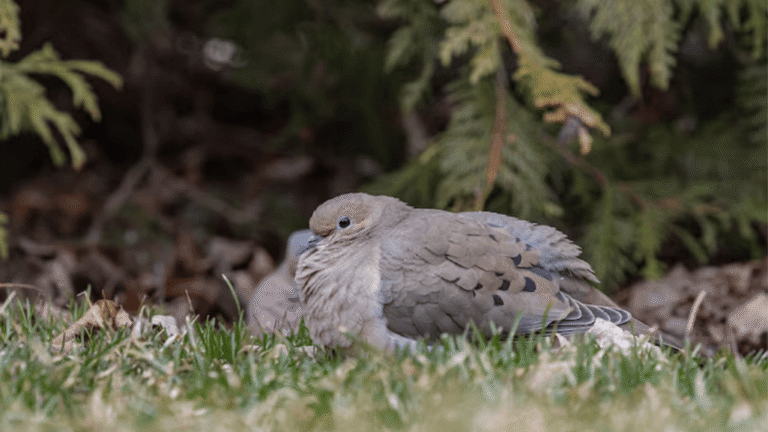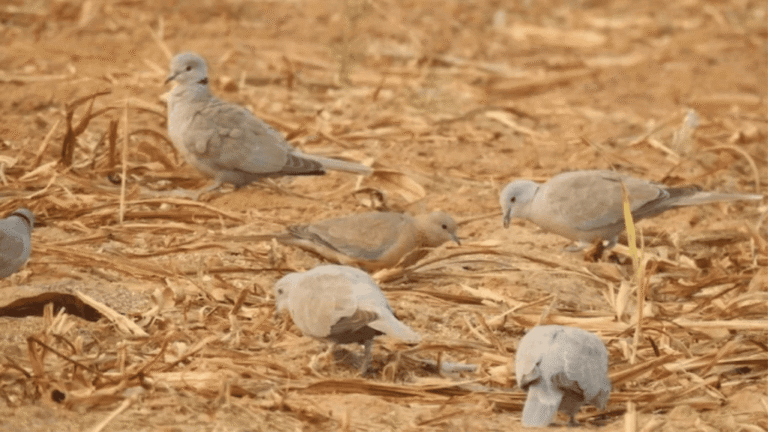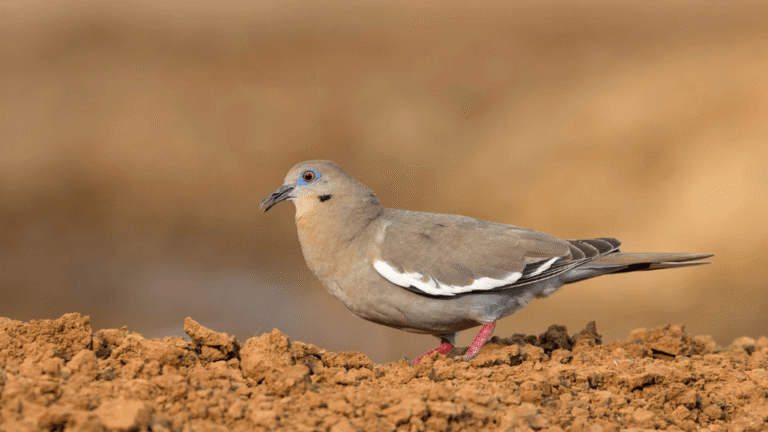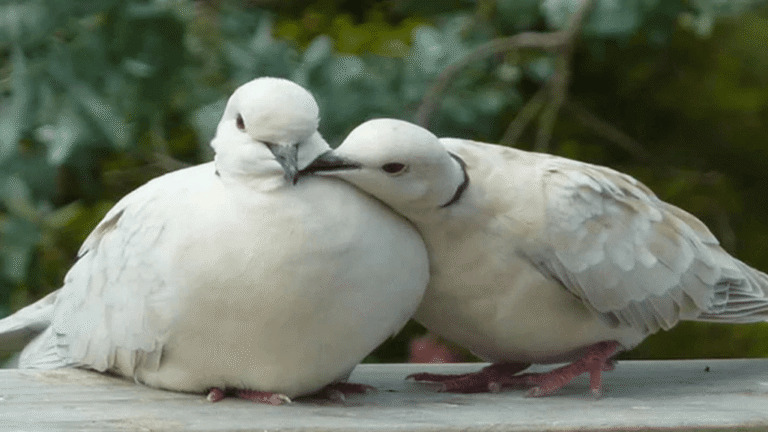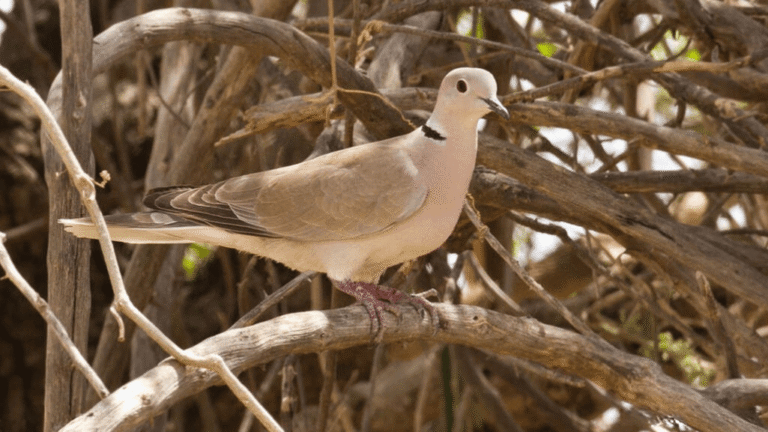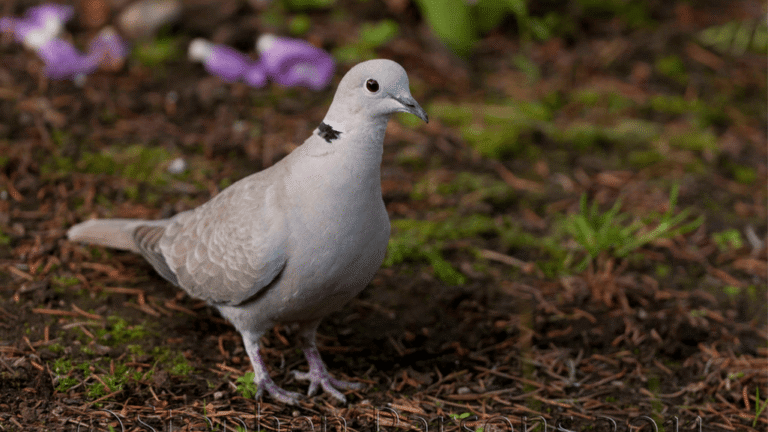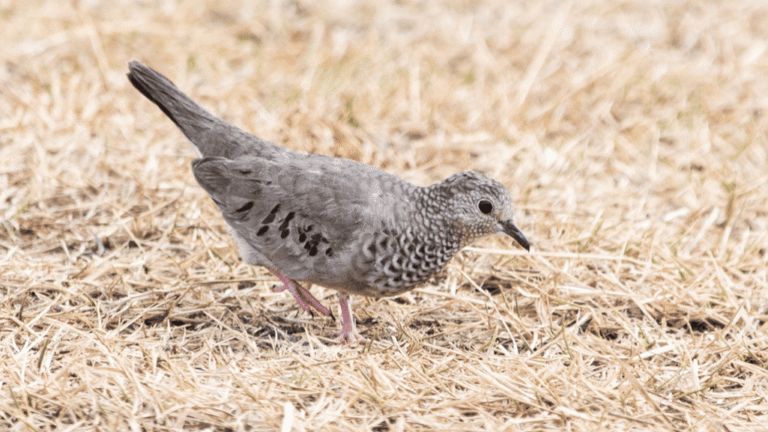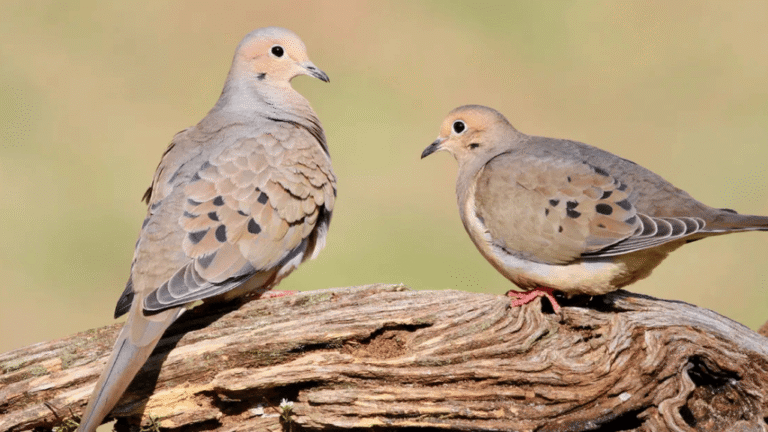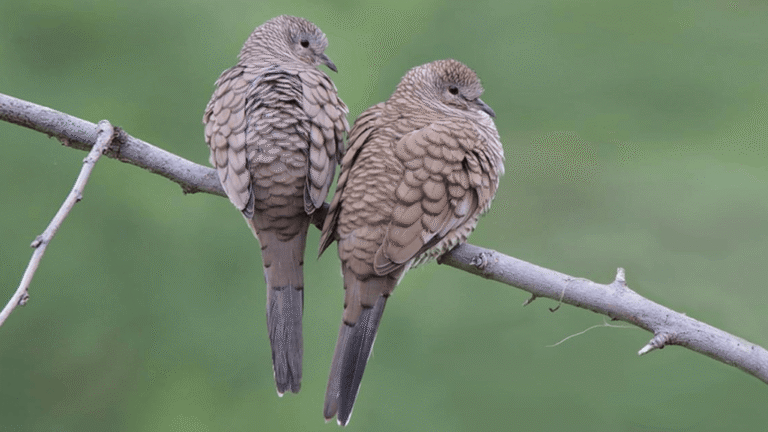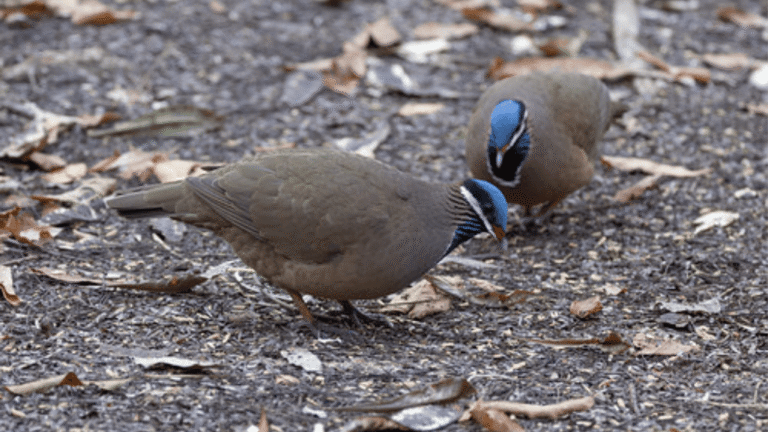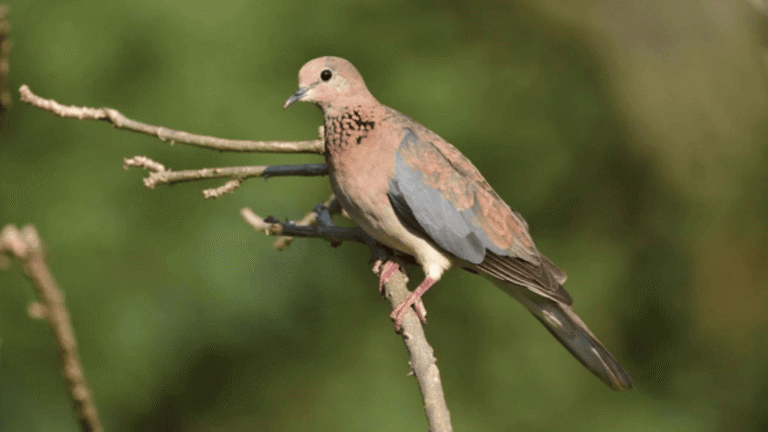The Common Ground Dove (Columbina passerina) is a tiny ground-dwelling bird found across much of North America. Roughly the size of a House Sparrow, this small dove is frequently spotted foraging for seeds on the ground in open areas such as grasslands, scrub, and city parks — making it a familiar sight for birdwatchers and naturalists.
One of the smallest doves in North America, the Common Ground Dove measures about 15–18 cm (6–7 inches) in length and typically weighs between 26–40 g. Its compact size, scaled head and chest pattern, and ground-oriented behavior help distinguish it from larger doves and other small birds.
Regional color variation is common: birds in the Southeast and Texas tend to show darker, warmer tones, while populations in the Southwest are paler and grayer. These subtle differences make the species interesting to watch across its range.
Key Takeaways
• The Common Ground Dove is among the smallest dove species in North America (Columbina passerina).
• It forages mainly on the ground, eating seeds and small invertebrates.
• Populations show regional color variation across their range.
• Pairs commonly remain together and can raise multiple broods each year.
• This species can drink by sucking and swallowing, allowing quick visits to water sources like bird baths.
Introduction to the Common Ground Dove
The Common Ground Dove is a small member of the Columbidae family found in natural and urban areas across the southern U.S., Mexico, and Central America. Adaptable and often inconspicuous, this dove is an important seed-eating bird in many habitats.
Characteristics of the Common Ground Dove
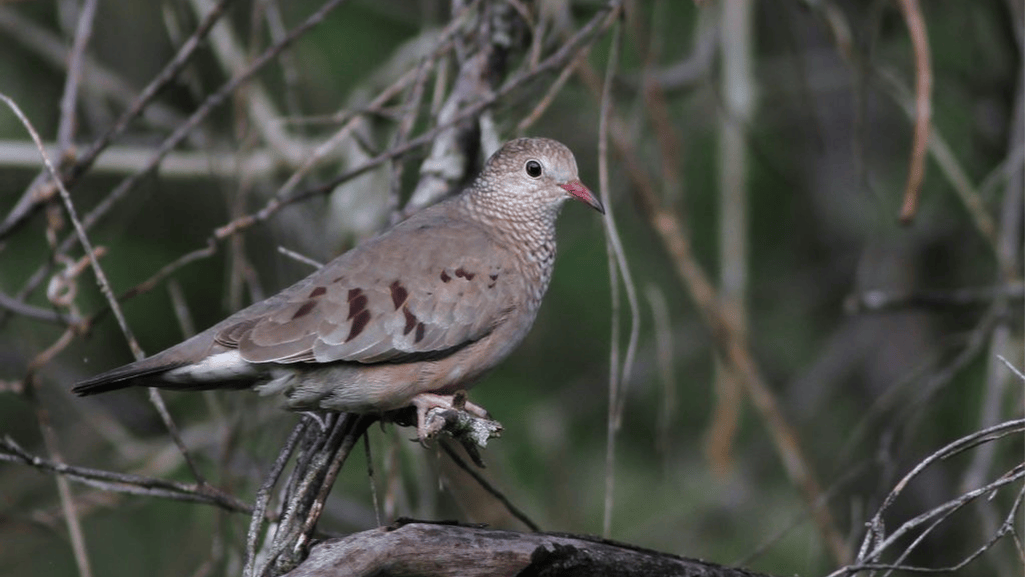 The Common Ground Dove is very small for a dove, measuring about 15–18 cm (6–7 in) in length and typically weighing between 26–40 g. Its compact size, scaled-looking feathers on the head, neck, and upper breast, and modest, rounded shape distinguish it from larger doves and many small birds.
The Common Ground Dove is very small for a dove, measuring about 15–18 cm (6–7 in) in length and typically weighing between 26–40 g. Its compact size, scaled-looking feathers on the head, neck, and upper breast, and modest, rounded shape distinguish it from larger doves and many small birds.
Distribution and Habitat
Common Ground Doves occur across the southern United States (from California and the Southwest to Florida and the Southeast), and extend through Mexico and Central America into parts of northern South America. They inhabit open, warm areas — dry scrub, grasslands, coastal dunes, and city parks — and readily use both natural and human-altered areas.
Significance in North American Avifauna
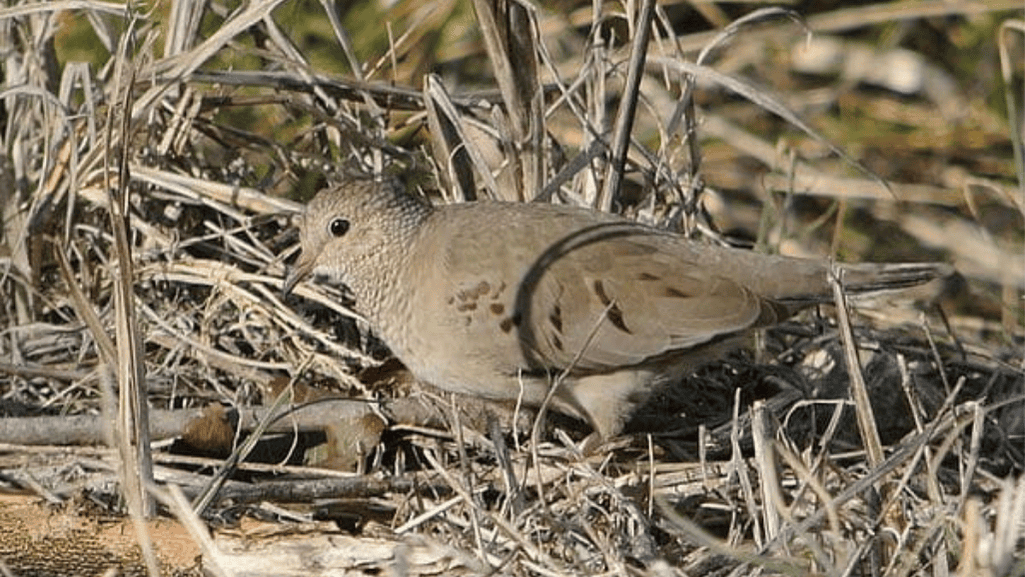 As a ground dove that feeds largely on seeds, this species contributes to seed dispersal and the dynamics of plant communities. Estimates of seed intake vary by study and location; many diets center on grass and weed seeds. Their tolerance of urban and suburban areas demonstrates their adaptability and ecological role among urban birds.
As a ground dove that feeds largely on seeds, this species contributes to seed dispersal and the dynamics of plant communities. Estimates of seed intake vary by study and location; many diets center on grass and weed seeds. Their tolerance of urban and suburban areas demonstrates their adaptability and ecological role among urban birds.
Characteristic Common Ground Dove Ruddy Ground-Dove Plain-breasted Ground-Dove
Length 15–18 cm 16.5–18 cm 14.5–16 cm
Body Mass 26–40 g 40–56.5 g 26–42 g
Distinctive Features Scaled head/neck/chest; pinkish-red bill base; chestnut wing patches Brick-red males, darker females; black wing spots Violet wing spots; plain brownish-gray plumage
Physical Appearance and Identification
The Common Ground Dove is compact (about 6–7 inches overall), roughly similar in size to a House Sparrow but with a stouter body and shorter tail. Its upperparts are sandy-brown to gray-brown with fine, scaled markings on the head and breast. In flight, small chestnut patches are visible on the wings. Males often show a warmer, slightly pinkish wash on the head and upper breast; females and immature birds are duller.
Key field marks: short rounded wings, short tail, scaled pattern on the head/upper breast, pinkish-red bill base with darker tip, and small chestnut wing patches visible in flight.
Dove Species Size (inches) Key Features
Common Ground Dove 6–7 Scaled head and breast, chestnut wing patches
Mourning Dove 9–13 Long, pointed tail
White-winged Dove 9–10 Bold white wing patch in flight
Inca Dove 8–9 Overall scaly appearance with longer tail
Common Ground Doves show regional color variation: birds in the Southeast and Texas often appear darker and warmer, while southwestern birds tend to be paler and grayer. These regional differences are subtle but useful for observers learning variations across the species’ range.
Habitat Preferences and Adaptations
The Common Ground Dove occupies a wide variety of warm, open areas across its range. It is most abundant in the southern United States but also occurs through Mexico, Central America and into parts of northern South America. This ground-oriented dove does well in both natural and human-altered areas.
Natural Habitats
Common Ground Doves prefer open woodlands, scrublands, dry grasslands, coastal dunes, and other semi-open sites. In arid regions they are commonly found in desert washes and scrub; in agricultural regions they often use field edges and fallow plots. Their range and habitat use are influenced by local seed availability and cover.
Urban and Suburban Environments
These doves adapt readily to towns and suburbs, turning up in city parks, yards, and roadsides. They frequently forage near bird feeders, gravel driveways, and bird baths. Urban observers should look for them on the ground beneath shrubs or along lawn edges, especially at dawn and late afternoon.
Adaptations for Ground-Dwelling
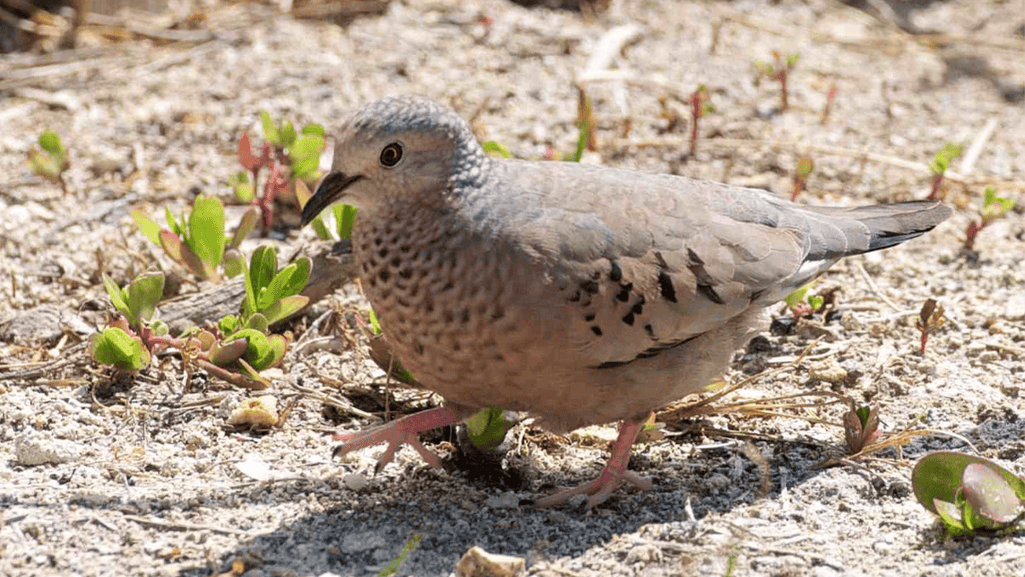 Common Ground Doves have short legs and a compact body that suit ground foraging. Their cryptic, sandy-brown plumage and scaled pattern on the head and breast provide camouflage in dry, open areas. Behaviorally, they tend to forage near cover and use quick, low flights to escape predators.
Common Ground Doves have short legs and a compact body that suit ground foraging. Their cryptic, sandy-brown plumage and scaled pattern on the head and breast provide camouflage in dry, open areas. Behaviorally, they tend to forage near cover and use quick, low flights to escape predators.
Habitat Type Characteristics Adaptations
Open Woodlands Scattered trees, grassy understory Ground foraging, quick flights to cover
Desert Areas Arid, sparse vegetation Heat tolerance, efficient water use
Urban Landscapes Parks, gardens, sidewalks Tolerance of people; uses bird baths and feeders
Observer tips: check dry, sandy patches, citrus groves, coastal dunes, and yard edges where seeds accumulate. Because the species forages on the ground for seeds, small patches of bare ground near shrubs are especially productive areas to find them.
Behavioral Traits and Daily Activities
Ground dove behavior during foraging
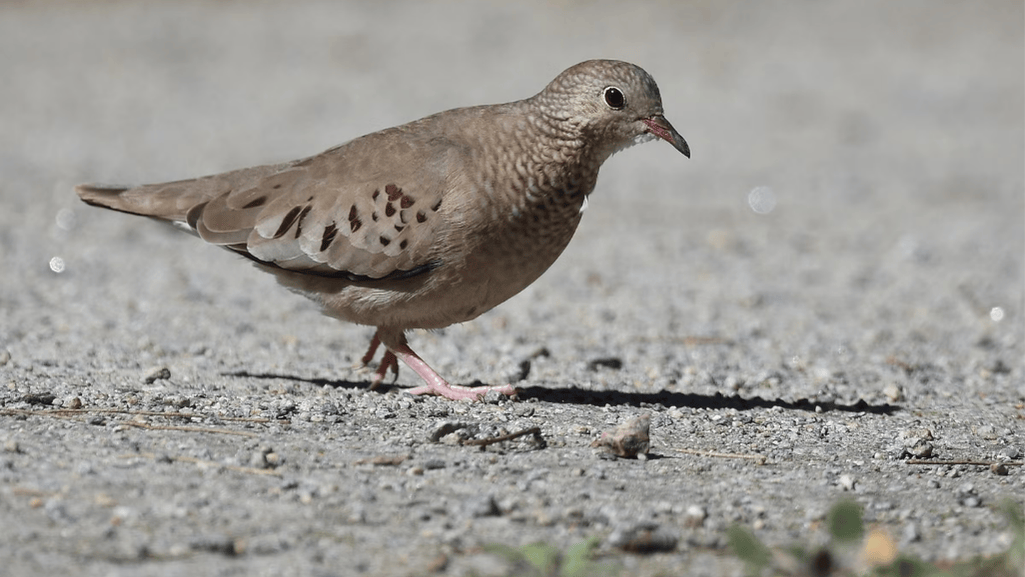 Common Ground Doves spend much of their time on the ground, where they carefully search for seeds and small invertebrates. Their foraging gait includes a characteristic head‑nodding motion that, along with their cryptic plumage, helps them blend into open, dry substrates while feeding.
Common Ground Doves spend much of their time on the ground, where they carefully search for seeds and small invertebrates. Their foraging gait includes a characteristic head‑nodding motion that, along with their cryptic plumage, helps them blend into open, dry substrates while feeding.
These doves are typically seen in pairs or small loose groups. Pair bonds are strong; pairs often remain together throughout the year, with males commonly performing brief wing‑flick displays and soft calls to mark territory or communicate with a mate.
Foraging is central to their daily routine. Common Ground Doves forage mainly on the ground for seeds and will visit water sources such as bird baths and small ponds. They are adaptable across urban to desert areas, taking advantage of seed concentrations along paths, driveways, and field edges.
Behavior Description
Foraging Ground-based, seed-focused; often near cover
Movement Walking with head-nodding motion; short, quick flights to cover
Social Structure Pairs or small flocks
Territorial Display Wing flicking and soft, two‑syllable calls
Young birds grow quickly and may be capable of breeding within a few months, which allows the species to produce multiple broods in favorable years.
Diet and Foraging Habits
Common Ground Doves primarily eat seeds, supplemented by small insects at times. Diets are dominated by grasses, weed seeds, and millet where available. Reports of daily seed intake vary by study and location; give numerical estimates context and cite local studies when publishing specific figures.
Seed-Based Diet
These doves feed on seeds from grasses, grains, and weeds found on bare patches and among vegetation. They use a crop to temporarily store and soften seeds before digestion.
Foraging Techniques
They favor dry, sandy patches, citrus groves, coastal dunes, and similar habitats where seeds concentrate. Foraging is often done in pairs or small groups; birds stay close to cover to reduce predation risk.
Importance of Water Sources
Water is important for Common Ground Doves, and they regularly visit shallow sources. Like other doves, they drink by sucking and swallowing, enabling quick drinks while remaining alert for predators.
Foraging Habitat Primary Food Sources Notes
Dry, sandy areas Grass seeds, weed seeds, millet Look near bare ground patches and shrub edges
Observation tips: check early morning and late afternoon at yard edges, driveways, gravel patches, and under shrubs. If you put out millet or small seed mixes, watch near ground level — Common Ground Doves often forage where seeds accumulate.
Breeding and Reproduction
Common Ground Dove breeding
Common Ground Doves breed opportunistically across much of their range, taking advantage of times and places with abundant seeds. Breeding activity is prolonged in warm regions—for example, pairs may breed from January through November in parts of California—while timing is more restricted in marginal or seasonal areas. Typical clutches contain two eggs, and pairs can raise multiple broods in a favorable year.
Both parents provision young with nutrient‑rich crop milk produced in the esophagus; this shared parental care helps nestlings grow rapidly. Incubation is generally short (about 12–14 days) and fledging occurs quickly (young often leave the nest roughly 10–12 days after hatching), which allows for multiple nesting attempts when conditions permit.
Breeding Characteristic Details
Breeding Season Prolonged in warm areas (e.g., Jan–Nov in parts of California)
Eggs per Clutch 2
Broods per Year Often 2–3 when conditions are good
Incubation Period ~12–14 days
Fledging Period ~10–12 days
The ability to breed quickly and produce crop milk helps Common Ground Doves exploit transient seed pulses (for example, after rains or fires). Observers should take care not to disturb nesting pairs: approach nests slowly, limit visits, and avoid handling young.
Common Ground Dove Vocalizations
These small doves are quieter than many larger species but use soft calls and wing sounds to communicate. Male vocalizations are a key cue during the breeding season.
Distinctive Calls and Sounds
Males produce a low, soft cooing—often described as a gentle “whoop” or moaning note—to attract mates and maintain pair bonds. Calls increase in frequency during courtship and territory defense.
Communication Patterns
Calls serve multiple functions: mate attraction, pair contact, and alarm signaling. In flight, wing beats may produce a faint whistling or whirring noise that can alert nearby birds.
Regional Variations in Calls
Subtle regional differences in call tempo and pitch may occur across the species’ broad range; detailed acoustic studies are limited, so documenting local calls (for example, via audio uploads to citizen‑science platforms) can be valuable.
Practical notes for observers: look for nesting pairs in low shrubs, trees near open ground, or sometimes on human structures. Watch from a distance during nesting season, and record call details (time, location, behavior) rather than repeatedly flushing adults from nests.
Conservation Status and Threats
Populations of Common Ground Doves face conservation concerns in parts of their range, particularly in the southeastern United States where declines have been reported. Habitat loss and conversion of open, seed‑rich areas to intensive agriculture, housing, or monocultures are widely cited as primary threats to this small ground‑dwelling species.
Population estimates vary by data source; for example, Breeding Bird Survey and range assessments provide broad-scale numbers but trends can differ locally. Because monitoring is patchy in some areas, more research is needed to clarify long‑term trends across the species’ entire range.
Compared with other doves, Common Ground Doves have experienced different trend patterns: widespread species like the Mourning Dove number far more individuals continentally, while White‑winged Doves show different regional trajectories. These contrasts highlight how land‑use change can affect similar species in different ways.
Conservation actions should focus on protecting and restoring open, seed‑bearing habitats across the species’ range — from coastal dunes and scrub to inland grassland patches. Practical steps include maintaining small patches of bare ground and native seed‑producing plants, reducing broad‑spectrum pesticide use, and preserving low shrubs and hedgerows that provide nearby cover for nesting and roosting.
Research gaps and monitoring priorities: standardized, range‑wide surveys (for example, targeted Breeding Bird Survey routes and increased eBird sampling), demographic studies in southern versus northern parts of the range, and investigations into causes of local declines (habitat loss, predation, pesticide impacts, or climate effects).
How you can help: report sightings and breeding evidence on citizen‑science platforms (e.g., eBird), favor native seed‑producing plants in gardens, and support local conservation groups working to protect open areas. For state conservation status or recommended actions, consult regional lists and resources (state wildlife agencies, Audubon, Cornell Lab) via their websites and follow links to local stewardship programs.
Interesting Facts and Unique Adaptations
Common Ground Doves possess several distinctive traits that suit a ground‑oriented lifestyle and make them rewarding to watch.
Flight Characteristics
When flushed, these small doves take off in a quick, low flight that often produces a faint whirring or whistling noise from the wings. The sound is caused by feather structure in the wing and can startle predators, giving the bird a brief advantage as it escapes to nearby cover.
Crop Milk Production
Like other doves, both parents produce nutrient‑rich crop milk in the esophagus to feed nestlings. This parental provisioning helps young grow rapidly and allows Common Ground Doves to raise multiple broods when food is available.
Predator Avoidance Strategies
Camouflage is a primary defense: the sandy‑brown feathers and scaled pattern on the head and breast blend with bare ground and dry vegetation. If threatened, they prefer to freeze or run short distances before making a sudden flight to cover, often in pairs.
Range and Ecology
Common Ground Doves are widespread across warm areas of the southern U.S., Mexico, and Central America, occupying open patches where seeds accumulate. They play a role in seed dynamics and are prey for mammals, snakes, and raptors — part of the complex food web in these areas.
Conclusion
The Common Ground Dove is a small, adaptable bird that thrives in both natural and urban landscapes. At roughly 15–18 cm (6–7 in), it is easily overlooked but important: it consumes seeds, supports predator species, and reproduces rapidly when conditions permit. Though not currently listed as globally endangered, local declines in some areas underline the need for habitat conservation and monitoring.
FAQ
What is the Common Ground Dove?
The Common Ground Dove (Columbina passerina) is a small ground‑foraging dove found in warm areas of North and Central America.
What does it look like?
Small and compact, with sandy‑brown feathers, a scaled pattern on the head and breast, small chestnut wing patches in flight, a short tail, and a pinkish‑red bill base. Males show a slightly warmer wash on the head and breast than females.
Where does it live?
Open woodlands, scrub, grasslands, coastal dunes, and urban edges across its range from the southern U.S. through Mexico and Central America.
What does it eat?
Primarily seeds (grass and weed seeds, millet), with occasional insects; they forage on the ground and use a crop to store and soften seeds.
How do they breed?
Pairs typically lay two‑egg clutches, both parents feed young with crop milk, incubation is short (~12–14 days) and fledging follows quickly, enabling multiple broods in good years.
How can I help?
Support conservation of open, seed‑bearing patches, reduce pesticide use, plant native seed‑producing plants, and report sightings (for example, via eBird) to help monitor local populations. For more information and regional status, consult local state lists and resources such as Audubon or the Cornell Lab (see respective websites for links and lists).


